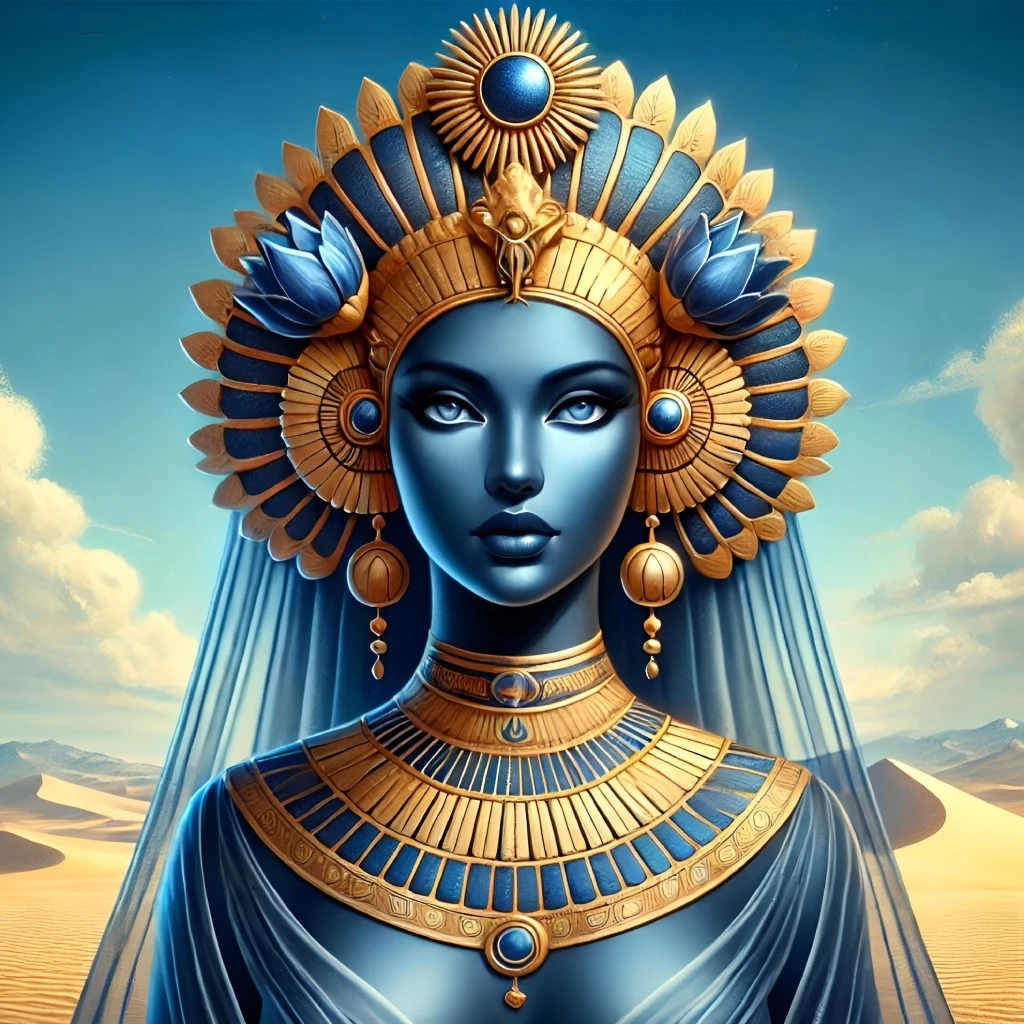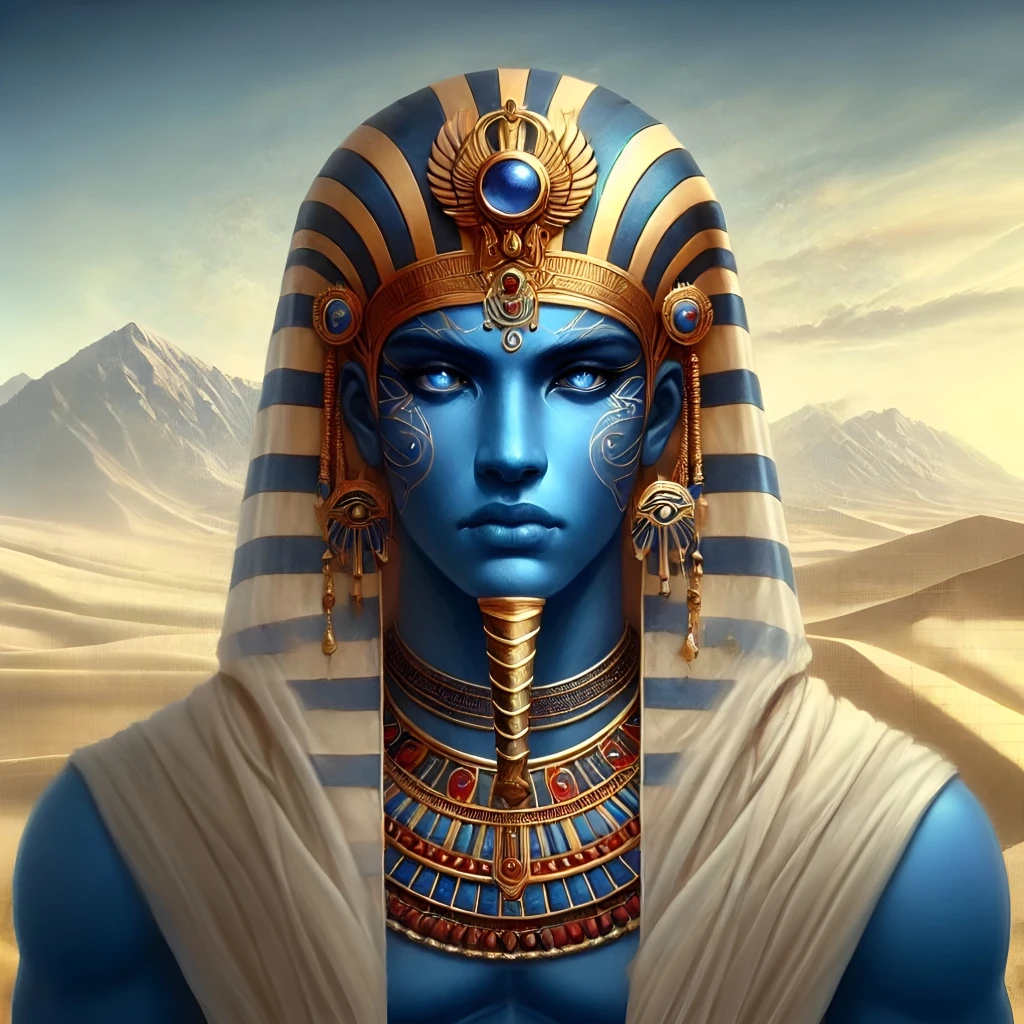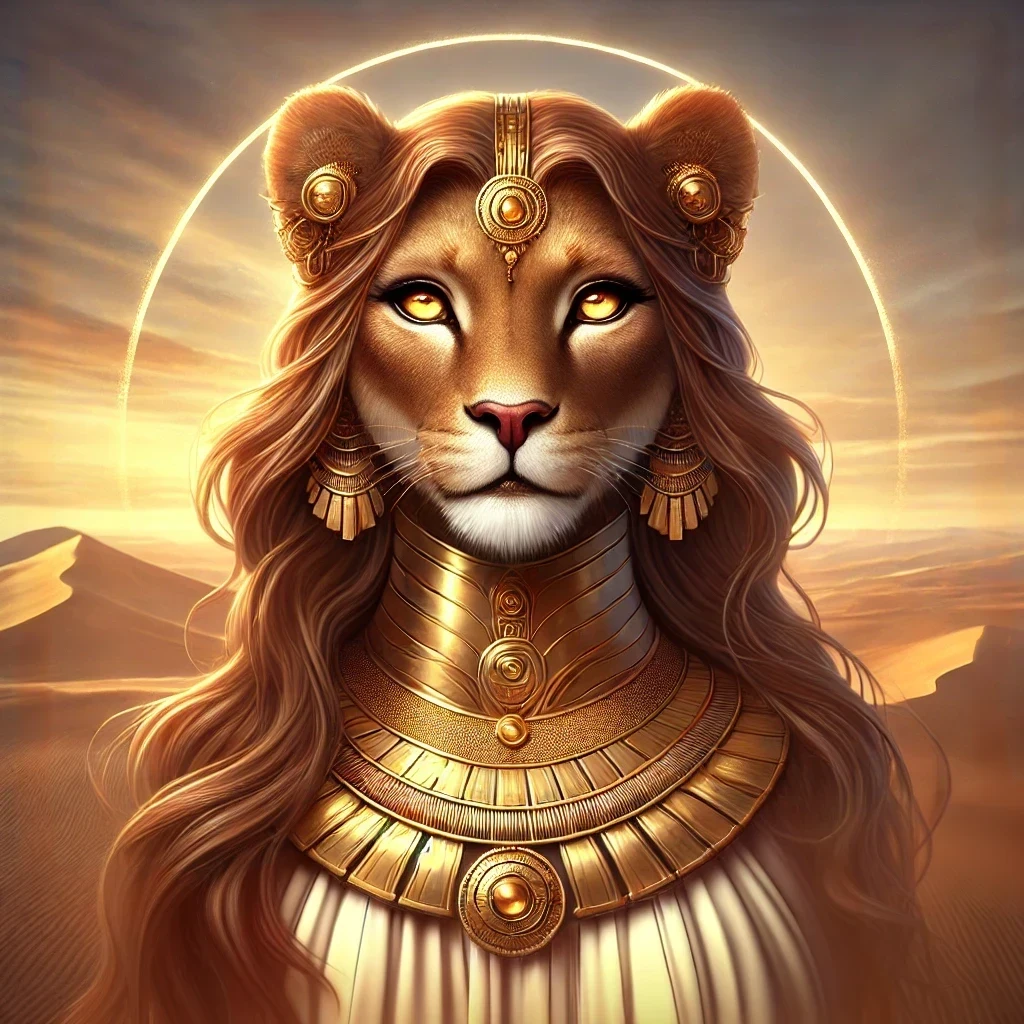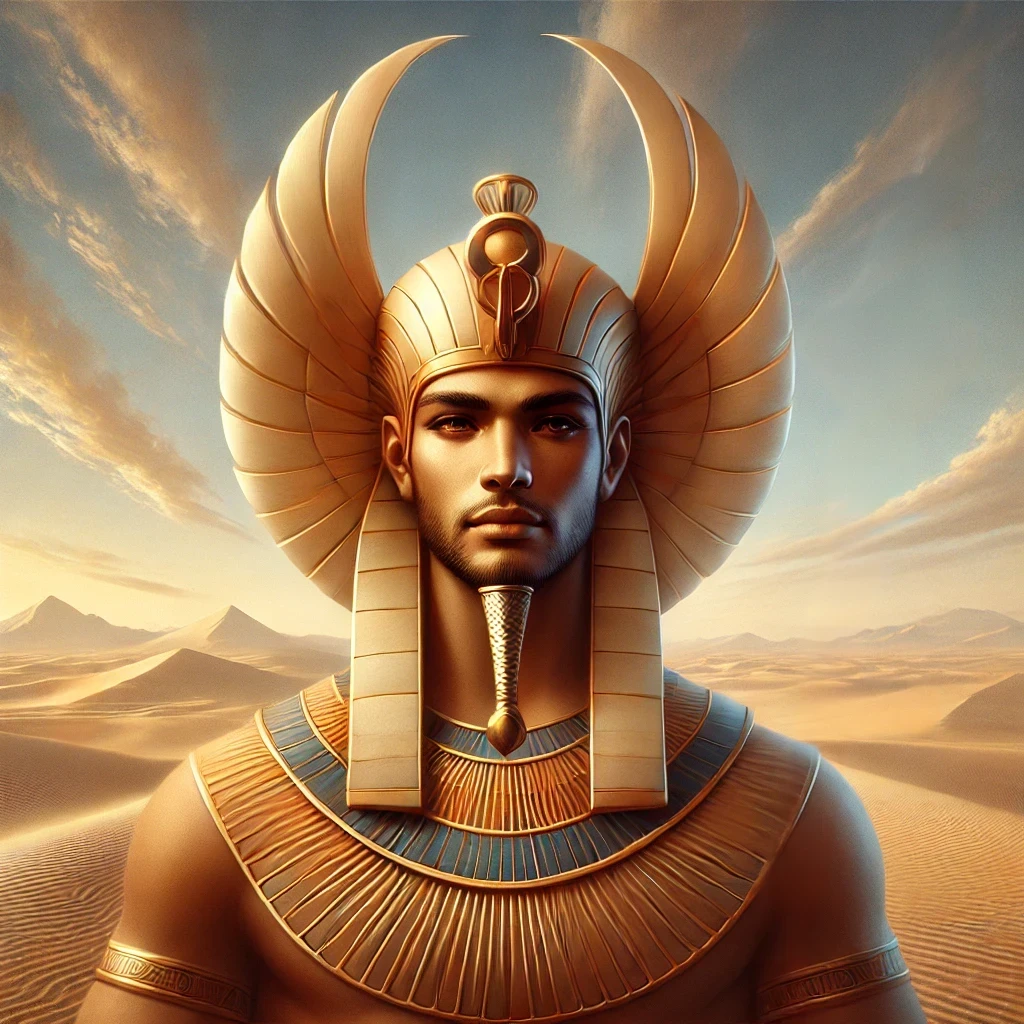Amunet, whose name translates to “The Hidden One,” was an ancient Egyptian goddess deeply tied to the earliest religious traditions of the civilization. Revered as a primordial force of creation, she was associated with air, invisibility, and the unseen power behind existence. As one of the eight deities of the Ogdoad in Hermopolis, she personified the feminine aspect of the hidden, complementing her male counterpart, Amun. Known as “She Who Is Hidden” and “The Veiled One,” this enigmatic goddess maintained an enduring but often overlooked presence in Egyptian theology. Though she eventually faded from prominence, her influence persisted through her association with major deities of the New Kingdom and beyond.
Origins
The Primordial Ogdoad
The earliest references to Amunet emerge from the Hermopolitan cosmology, where she formed part of the Ogdoad—eight deities embodying fundamental aspects of creation. Alongside her consort, she represented the unseen force behind the emergence of the universe. The Ogdoad deities were divided into four male and four female pairs, each embodying a different concept of primordial chaos. The goddess and her consort represented the hidden and formless aspect, emphasizing the unseen forces shaping existence.
Within the mythology of the Ogdoad, the primordial deities worked together to bring about creation from the chaotic waters. Their interactions culminated in the emergence of the first land and, ultimately, the birth of the sun god, who brought order to the universe. In this way, she was a foundational figure in Egyptian cosmogony, embodying the hidden forces that set the stage for the visible world.
Relationship with Amun
As Amun rose to prominence in Thebes, the goddess remained an integral figure, often appearing as his feminine counterpart. Initially equal in status, she was later overshadowed by Mut but continued to feature in temple inscriptions and religious traditions. Some scholars suggest that her presence in early Theban religious thought predates even Amun’s more widespread worship, reinforcing her role as an ancient and foundational deity.
In early representations, Amun and Amunet were depicted together as a divine pair. They symbolized both the unknowable and the manifest aspects of divinity—Amun as the unseen god of air and wind, and his consort as the counterpart of mystery and veiled influence. Their unity embodied a divine completeness, a balance of the concealed and the revealed, an essential component of Egyptian theological principles.
Integration into Later Religious Thought
Over time, Amunet was assimilated into broader theological constructs. During the Middle Kingdom, her connection to Amun grew more symbolic, as Thebes became a center of power and its religious landscape evolved. Her role was gradually merged with that of Mut, but remnants of her worship remained in rituals emphasizing the hidden aspects of divine influence.While her presence diminished in mainstream theology, elements of her influence persisted. In temple inscriptions and religious texts, her name and attributes often appeared alongside Amun’s, reinforcing her enduring but subtle presence within the evolving Egyptian religious framework. Her aspect as the hidden and unknowable became an archetypal concept within Egyptian mysticism, influencing later religious traditions.
Appearance
Depictions in Art
She was frequently depicted as a woman wearing the Red Crown of Lower Egypt, symbolizing her authority and connection to the land’s northern regions. In some representations, she appears with a staff and papyrus scepter, reinforcing her ties to creation and sovereignty. Unlike many other goddesses, her depictions were rare, reflecting her association with invisibility and the unseen.
The rarity of her visual representations underscores her nature as an elusive and mysterious force. Unlike deities with well-defined appearances, Amunet was often depicted in subtle, minimalistic ways, reinforcing her role as an unseen presence rather than a physically manifest entity. Some depictions even show her as a mere inscription or a secondary figure beside Amun, further emphasizing her veiled existence.
Symbols and Attributes
Unlike more anthropomorphized goddesses, she was often illustrated with minimal detail, reinforcing her connection to the hidden and unseen forces of the cosmos. The lack of physical representation highlights her role as a conceptual deity, an idea rather than a tangible form.
Her symbols include the Red Crown, the papyrus scepter, and, in some cases, the ankh, signifying her connection to the life force and the unseen breath that animates existence. The wind itself was often seen as one of her manifestations, emphasizing her unseen but ever-present nature.
Changes in Artistic Representation
As Egyptian religious traditions evolved, depictions of the goddess became increasingly stylized. By the New Kingdom, she was often reduced to inscriptions rather than full statues or murals, signaling her transition from an active deity to a symbolic presence within Amun’s theological framework.
Abilities
The Power of Invisibility
A defining trait of Amunet was her ability to exist beyond mortal perception. She embodied the unseen breath of life and the mysterious forces guiding existence. This made her particularly significant in rites emphasizing protection, divine intervention, and unseen guidance.
In some texts, she is described as the whisper of the wind, the unseen voice that carries divine will across the land. She was called upon in moments of uncertainty, offering guidance through intuition and hidden knowledge rather than direct revelation.
Influence in Creation
As a primordial goddess, she played a role in the formation of the cosmos, embodying the formless void from which all things emerged. The concept of hidden creation was essential in Egyptian religious thought, and her role in shaping existence made her an important figure in early cosmology.
Some priests and scribes invoked her in spells and rituals seeking insight into the unknown. She was associated with oracles and hidden wisdom, making her an important figure in divination and prophetic traditions.
Connection to Divine Authority
Because she was the unseen counterpart of Amun, her influence extended to kingship and divine legitimacy. Pharaohs invoked her name in rituals that emphasized their connection to divine, hidden forces, ensuring their rule was sanctified by the gods.divine, hidden forces, ensuring their rule was sanctified by the gods.
Protective Aspects
Amunet was often called upon in protective rituals, ensuring the unseen forces guided and shielded individuals from harm. Her presence was invoked in temples, particularly during transitions of power, reinforcing her role as a guardian of divine stability.
Domain
The Hidden Forces of the Universe
Amunet ruled over the unseen aspects of reality, particularly air, wind, and the intangible elements of existence. Unlike deities with defined physical realms, her domain encompassed abstract and conceptual forces. Egyptian religious texts often emphasized the necessity of hidden forces to maintain balance and order, reinforcing her importance despite her lesser-known status.
The Feminine Principle of Creation
While often overshadowed by more prominent goddesses, she remained a crucial figure in theological traditions emphasizing balance and duality in creation. As a counterpart to Amun, she ensured that the hidden forces of creation complemented the visible world.
Myths
The Ogdoad and the Cosmic Egg
One of the most significant myths involving Amunet describes her participation in the cosmic union that generated the primeval egg, from which the sun god emerged, bringing order to chaos. This creation myth underscored her role as a fundamental force within the cosmic cycle.
The Hidden Consort of Amun
Though overshadowed by later narratives emphasizing Mut, earlier texts highlight her role as Amun’s original partner, emphasizing the duality of visible and invisible forces. Some versions of the myth suggest that she played a role in Amun’s ascension to supremacy, serving as the unseen support behind his power.
Role in Esoteric Traditions
Later Egyptian mystical practices sometimes referenced her as an intermediary between the mortal world and the divine, invoking her power to access hidden knowledge and deeper spiritual understanding.
Symbolism
Associated Objects
The papyrus scepter, a symbol of Lower Egypt and fertility, was one of her primary emblems, linking her to life-giving forces. Additionally, her association with air and invisibility made her a recurring figure in protective spells and inscriptions.
Sacred Animals
Unlike many deities, Amunet lacked a singular sacred animal but was occasionally associated with creatures linked to secrecy and subtlety, such as the serpent. In some religious traditions, serpents were viewed as guardians of hidden knowledge, reinforcing her connection to esoteric wisdom.
Cosmic Balance
Her presence in temple inscriptions often emphasized balance, aligning her with the unseen equilibrium that maintained cosmic stability, particularly in the realms of divine justice and authority.
Worship
Temples and Cult Centers
Amunet’s worship was centered in Thebes, where she was honored alongside Amun in early temple inscriptions before Mut gradually supplanted her. Some smaller shrines dedicated to early Theban deities included references to her, particularly in relation to hidden blessings and protection.
Rituals and Priesthood
Though less prominent than other goddesses, she was invoked in rituals emphasizing protection, invisibility, and divine guidance, particularly in temple rites dedicated to Amun. Priests would sometimes call upon her name in moments of uncertainty, seeking hidden wisdom and unseen intervention.
Persistence in Later Rituals
Even as her worship waned, echoes of her presence persisted in magical practices, particularly those seeking divine protection, knowledge, or blessings for rulers.
Associations
Connection to Amun
Despite later theological shifts, Amunet remained conceptually linked to Amun, representing his hidden power and complementary feminine aspect. In inscriptions where Amun was depicted as a supreme, unseen force, she often appeared as his balancing counterpart.
Links to Other Deities
She was sometimes associated with Neith, another ancient goddess embodying hidden wisdom, as well as Ma’at, reinforcing her role in cosmic balance. Though not as directly involved in justice as Ma’at, her unseen presence played a role in the maintenance of universal order.
Legacy
Decline in Prominence
As Thebes evolved, Amunet’s role diminished in favor of Mut, though traces of her worship persisted in temple inscriptions and religious texts. The shift in political and religious focus led to her gradual disappearance from mainstream Egyptian theology.
By the time of the Ptolemaic period, she had largely faded from mainstream worship, though echoes of her influence could still be seen in texts related to hidden wisdom and mystical traditions.
Enduring Influence
While largely absent from later Egyptian religion, her legacy endured through her early association with Amun and as a representation of the unseen forces shaping the cosmos. Elements of her influence can still be seen in esoteric traditions emphasizing hidden knowledge and protective rituals.
In modern interpretations of Egyptian mythology, she remains a symbol of mystery, unseen power, and divine influence beyond direct comprehension. Her name continues to inspire scholars and mystics alike, representing the balance between knowledge and the unknowable.
Trivia
- Unlike many other Egyptian goddesses, Amunet was rarely depicted in statues or murals, reinforcing her association with the unseen and the mysterious forces of the cosmos.
- Her name was sometimes inscribed alongside Amun’s in temple carvings as part of invocations meant to invoke hidden protection and divine guidance.
- Some esoteric traditions consider Amunet a precursor to later goddesses of secrecy and wisdom, such as Isis in her more mystical aspects.
- Amunet played a minor role in Egyptian funerary texts, where she was sometimes invoked to ensure safe passage through the Duat, the Egyptian underworld.
- During the New Kingdom, her role was almost entirely absorbed by Mut, yet traces of her presence remained in lesser-known priestly texts.
- A temple in Karnak featured inscriptions referring to her as “the breath that moves unseen,” reinforcing her connection to air and invisibility.
- Despite being a primordial deity, she never had a significant mythological narrative of her own, highlighting her role as a conceptual force rather than a narrative-driven deity.
- Some scholars believe that the shift from Amunet to Mut symbolized the transition from hidden power to a more maternal, nurturing representation of divine femininity.
- The priesthood of Amun in Thebes retained knowledge of her worship long after her decline, occasionally mentioning her in hidden or secondary inscriptions.
- Amunet’s name was invoked in magical spells intended to protect travelers and merchants.



